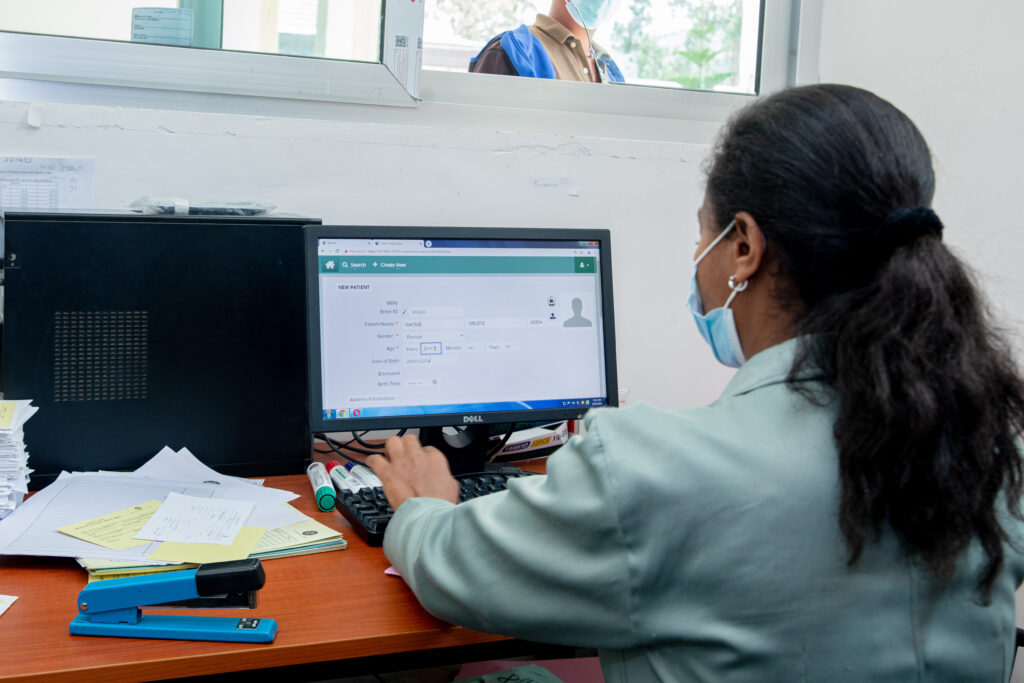Transforming Healthcare in Ethiopia: A Case Study of Ferensay Health Center
In the last decade, Ethiopia has committed to a complete digitization of its health sector, streamlining data and ensuring its use toward program decision-making. This is a massive undertaking and investment to correct issues plaguing client care experiences, including poor clinic workflows, medical product availability, and cost. Outcomes of this digital transformation are now coming into focus. At the forefront of the transformation stands the Ferensay Health Center – a busy and large health facility once overwhelmed with long patient waiting lines and chaotic workflows.
Ferensay is a high volume health center, not far from Addis Ababa. It addresses a comprehensive set of patient needs to a catchment population of more than 45,000. The center operates through eight outpatient departments and a central onsite laboratory and pharmacy. Internal communications between these services informing care continuums for patients was non-existent in years prior, forcing redundancies, gaps in care and less than optimal patient outcomes.
“Before, this area was overflowing with patients, especially in the mornings. We would scramble to locate records, with a large number of patients in the waiting area. It used to take patients, on average, about 30 minutes from when they entered the health center until the first contact with a doctor. Now, it takes an average of 10 minutes.” explains Tringo Haymanot, a staff member of Ferensey’s records department.
In 2022, the USAID-funded Digital Health Activity began supporting Ferensay to increase efficiency, build in autonomy to support inter-departmental communications, and create greater access to data for clinical and programmatic use. In the last few years, the facility implemented the Electronic Medical Records (EMR) system, the Electronic Auditable Pharmaceutical Transaction and Services (eAPTS), Vitas, and Dagu.
EMR, a digital medical chart, captures patient information like demographics, vital signs, notes, diagnoses, and treatment plans – data which could be easily retrieved in ongoing patient care. eAPTS, Vitas, and Dagu are electronic supply chain management solutions implemented by health centers and pharmacies to more accurately and effectively manage stock supply and communicate with one another and national stock stores. EMR integrates with the eAPTS pharmacy system, which connects to Dagu store management and Vitas distribution hubs, ensuring comprehensive health data management and medical supply tracking aligned with client needs. This integration facilitates tracking products from supply to consumers and enables quick and accurate client follow-up.

Key to Ferensey’s success in implementing these innovations was the full support of facility staff and managers. DHA provided access to these tools and crucial on-the-job training, while the health center leadership ensured the necessary infrastructure and equipment were in place. The health workforce, however, met obstacles in this process. For instance, clinicians encountered patient resistance to EMR usage, perceiving it as a barrier to personalized care.
“At first, patients used to express discomfort when seeing us interact with a screen while engaging with them.” Berhane G/Egizabeher, EMR Coordinator, explains. Realizing this in early use, Ferensay Health Center staff initiated a health education program for the community. This proactive engagement fostered client acceptance and contributed to the success of scale-up efforts, highlighting the pivotal role of community involvement in digital health initiatives.
Berhane continues, “The shift in patient perception, from skepticism to advocacy for EMR usage, exemplifies the transformative impact of collaborative efforts in healthcare delivery.”

Tigist Demisse, Pharmacy Head at Ferensey Health Center, explains how autonomy in supply management has brought much needed support to busy staff “We used to spend so much time identifying average consumption, and finding our products were near expiry, or expired. With eAPTS in the pharmacy, we now efficiently monitor and communicate with the store regarding drug status. This has simplified our inventory management – what used to take us 10 days on inventory tracking now takes us about two – and it has reduced frequency in errors and data discrepancies.”
The story of Ferensay Health Center serves as a beacon of hope and inspiration, showcasing what transformation can take place through digital solutions, a creative and dedicated workforce, and community engagement. As Ethiopia continues its journey toward universal healthcare coverage, initiatives like these pave the way for a brighter, healthier future for all.
